国际会计学第六版chapter(4)
- 格式:ppt
- 大小:1.20 MB
- 文档页数:15
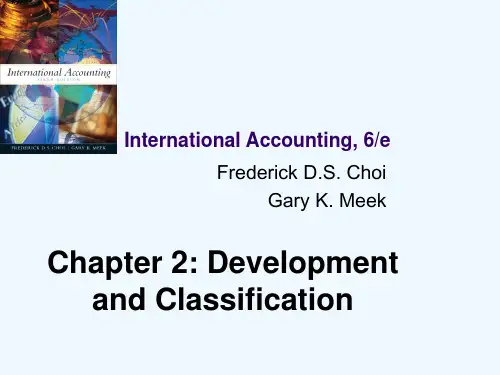
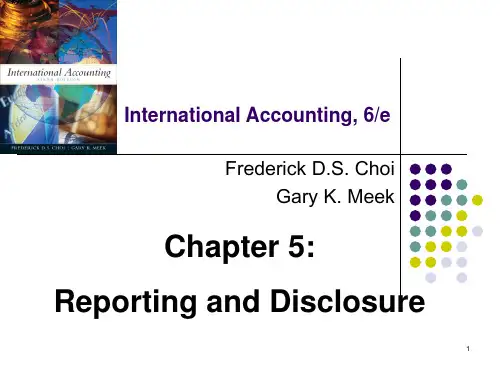
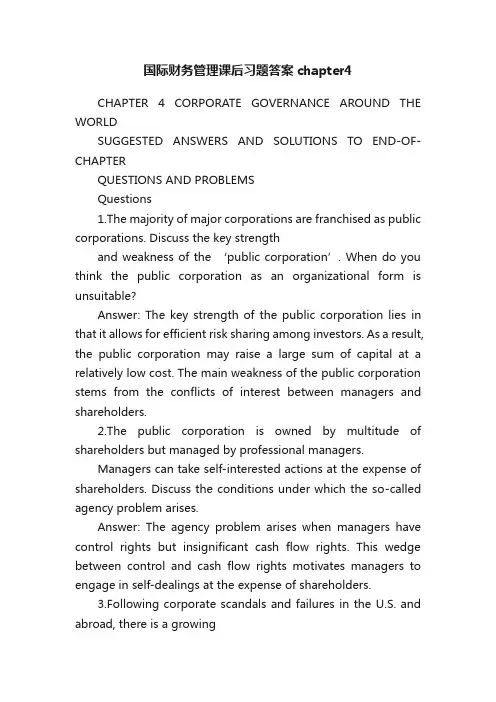
国际财务管理课后习题答案chapter4CHAPTER 4 CORPORATE GOVERNANCE AROUND THE WORLDSUGGESTED ANSWERS AND SOLUTIONS TO END-OF-CHAPTERQUESTIONS AND PROBLEMSQuestions1.The majority of major corporations are franchised as public corporations. Discuss the key strengthand weakness of the ‘public corporation’. When do you think the public corporation as an organizational form is unsuitable?Answer: The key strength of the public corporation lies in that it allows for efficient risk sharing among investors. As a result, the public corporation may raise a large sum of capital at a relatively low cost. The main weakness of the public corporation stems from the conflicts of interest between managers and shareholders.2.The public corporation is owned by multitude of shareholders but managed by professional managers.Managers can take self-interested actions at the expense of shareholders. Discuss the conditions under which the so-called agency problem arises.Answer: The agency problem arises when managers have control rights but insignificant cash flow rights. This wedge between control and cash flow rights motivates managers to engage in self-dealings at the expense of shareholders.3.Following corporate scandals and failures in the U.S. and abroad, there is a growingdemand for corporate governance reform. What should be the key objectives ofcorporate governance reform? What kind of obstacles can there be thwarting reformefforts?Answer: The key objectives of corporate governance reform should be to strengthen shareholder rights and protect shareholders from expropriation by corporate insiders, whether managers or large shareholders. Controlling shareholders or managers do not wish to lose their control rights and thus resist reform efforts.4.Studies show that the legal protection of shareholder rights varies a great deal acrosscountries. Discuss the possible reasons why the English common law traditionprovides the strongest and the French civil law tradition the weakest protection ofinvestors.Answer: In civil law countries, the state historically has played an active role in regulating economic activities and has been less protective of property rights. In England, control of the court passed from the crown to the parliament and property owners in seventeenth century. English common law thus became more protective of property owners, and this protection was extended to investors over time.5.Explain ‘the wedge’ between the control and cash flow rights and discuss its implications forcorporate governance.Answer: When there is a separation of ownership and control, managers have control rights with insignificant cash flow rights,whereas shareholders have cash flow rights but no control rights. This wedge gives rise to the conflicts of interest between managers and shareholders. The wedge is the source of the agency problem.6.Discuss different ways that dominant investors use to establish and maintain the control of thecompany with relatively small investments.Answer: Dominant investors may use: (i) shares with superior voting rights, (ii) pyramidal ownership structure, and (iii) inter-firm cross-holdings.7.The Cadbury Code of the Best Practice adopted in the United Kingdom led to a successful reform ofcorporate governance in the country. Explain the key requirements of the Code and discuss how it may have contributed to the success of reform.Answer: The Code requires that chairman of the board and CEO be held by two different individuals, and that there should be at least three outside board members. The recommended board structure helped to strengthen the monitoring function of the board and reduce the agency problem.8.Many companies grant stocks or stock options to the managers. Discuss the benefitsand possible costs of using this kind of incentive compensation scheme.Answer: Stock options can be useful for aligning the interest of managers with that of shareholders and reduce the wedge between managerial control rights and cash flow rights. But at the same time, stock options may induce managers to distort investment decisions and manipulate financial statements so that they can maximize their benefits in the short run.9.It has been shown that foreign companies listed in the U.S. stock exchanges are valued more thanthose from the same countries that are not listed in the U.S. Explain the reasons why U.S.-listed foreign firms are valued more than those which are not. Also explain why not every foreign firm wants to list stocks in the United States.Answer: Foreign companies domiciled in countries with weak investor protection can bond themselves credibly to better investor protection by listing their stocks in U.S. exchanges that are known to provide a strong investor protection. Managers of some companies may not wish to list shares in U.S. exchanges, subjecting themselves to stringent disclosure and monitoring, for fear of losing their control rights and private benefits.。
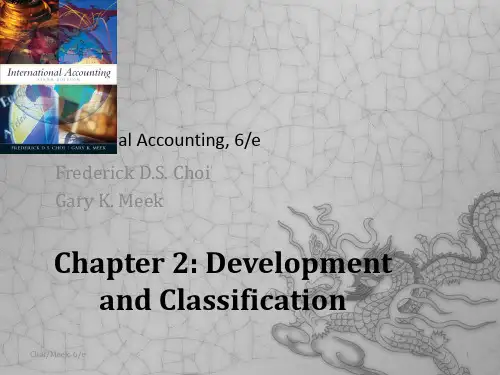
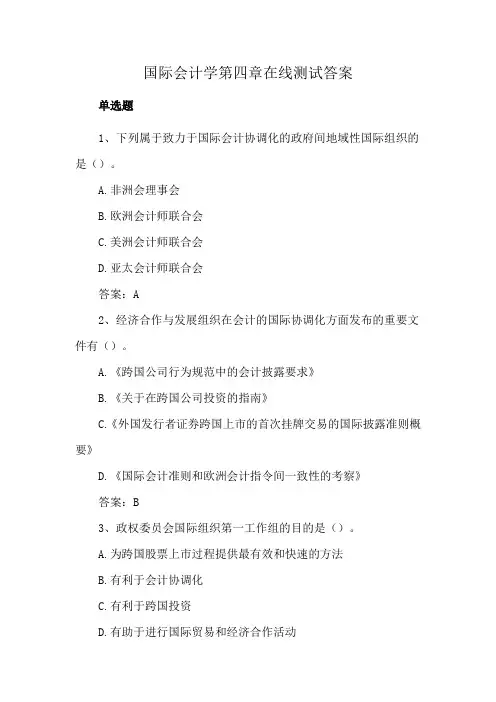
国际会计学第四章在线测试答案单选题1、下列属于致力于国际会计协调化的政府间地域性国际组织的是()。
A.非洲会理事会B.欧洲会计师联合会C.美洲会计师联合会D.亚太会计师联合会答案:A2、经济合作与发展组织在会计的国际协调化方面发布的重要文件有()。
A.《跨国公司行为规范中的会计披露要求》B.《关于在跨国公司投资的指南》C.《外国发行者证券跨国上市的首次挂牌交易的国际披露准则概要》D.《国际会计准则和欧洲会计指令间一致性的考察》答案:B3、政权委员会国际组织第一工作组的目的是()。
A.为跨国股票上市过程提供最有效和快速的方法B.有利于会计协调化C.有利于跨国投资D.有助于进行国际贸易和经济合作活动4、推动会计协调化最有成效的区域性国家联盟是()。
A.亚太经济合作组织B.证券委员会国际组织C.国际会计师联合会D.欧盟答案:D多项选择题1、会计协调化的作用在于()。
A.有助于进行国际贸易和经济合作活动B.促进了国外企业在国际货币市场融资,特别是在国际资本市场发行证券时需要提供的财务报表的可比性。
C.有利于跨国投资D.便于跨国公司合并其分布在世界各地的子公司的财务报表答案:ABCD2、下列属于致力于国际会计协调化的全球性国际组织的是()。
A.欧盟B.证券委员会国际组织C.经济合作发展组织会计工作组D.国际资产评估准则委员会答案:ABC3、欧盟发布的有关会计协调化的指令包括()。
B.第4号C.第6号D.第7号答案:ABCD4、证券委员会国际组织的常务机构包括()。
A.非洲/中东地区委员会B.太地区委员会C.欧洲地区委员会D.沙羊地区秀品会经这合作与发展组织答案:ABCD。
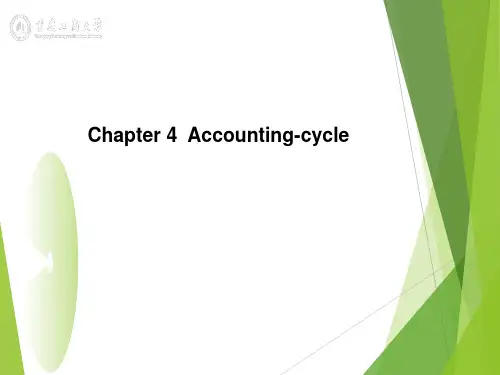
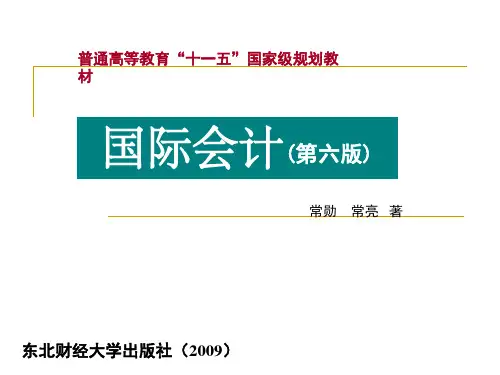


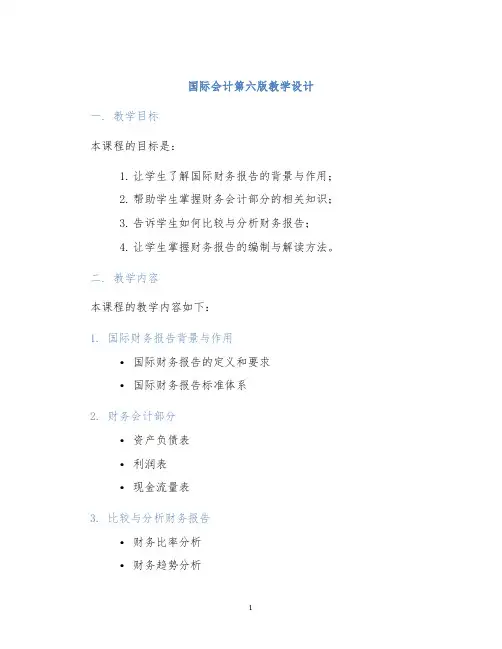
国际会计第六版教学设计一. 教学目标本课程的目标是:1.让学生了解国际财务报告的背景与作用;2.帮助学生掌握财务会计部分的相关知识;3.告诉学生如何比较与分析财务报告;4.让学生掌握财务报告的编制与解读方法。
二. 教学内容本课程的教学内容如下:1. 国际财务报告背景与作用•国际财务报告的定义和要求•国际财务报告标准体系2. 财务会计部分•资产负债表•利润表•现金流量表3. 比较与分析财务报告•财务比率分析•财务趋势分析•财务结构分析4. 财务报告的编制与解读方法•财务报告编制准则•财务报告解读技巧三. 教学方法1.讲课:通过PPT等教案,向学生阐述相关概念和知识点。
2.分组讨论:将学生分成小组,让每组讨论财务报告相关的案例和问题,提高学生的思考和沟通能力。
3.实践操作:让学生通过财务报告解读实践操作,加深其对财务报告理解。
四. 文献资料•Deegan, C. M. (2014). Financial Accounting Theory.4th ed. United States: Mcgraw-hill.•Kieso, D. E., Weygandt, J. J., & Warfield, T. D.(2016). Intermediate Accounting.16th ed. United States: John Wiley & Sons.•IFRS2018).IFRS Standards - Consolidated without early application. International Accounting Standards Board (IASB).五. 评价方法1.学生平时表现(40%):包括参与度、思考问题能力、作业完成情况等各方面表现。
2.期末论文(60%):学生需撰写一篇不少于3000字的论文,探讨财务报告某一方面的问题,如财务比率分析等。
六. 教学日程时间教学内容第1周国际财务报告背景与作用第2-4周财务会计部分第5-6周比较与分析财务报告第7周财务报告的编制与解读方法第8-9周学生小组讨论及实践操作第10周学生期末论文答辩七. 总结思考本课程是国际会计领域的入门课程,涉及到了财务报告的方方面面,因此,在教学设计中增加了分组讨论及实践操作环节,使得学生不仅能够掌握相关理论知识,还能够在实践中不断提高自己的分析与解读财务报告的能力。
